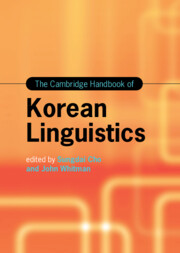Book contents
- The Cambridge Handbook of Korean Linguistics
- Cambridge Handbooks in Language and Linguistics
- The Cambridge Handbook of Korean Linguistics
- Copyright page
- Contents
- Figures
- Tables
- Contributors
- Preface
- Acknowledgments
- Abbreviations
- Part I Korean Overview
- Part II Phonetics and Phonology
- Part III Morphology and Syntax
- Chapter 12 Right-Dislocation in Korean: An Overview
- Chapter 13 Experimental Insights on the Grammar of Korean Anaphors
- Chapter 14 Person-Denoting Nominals: Interpretations and Structures
- Chapter 15 Lexical Nominalizations in Korean
- Chapter 16 The Processing of a Long-Distance Dependency in Korean: An Overview
- Part IV Semantics and Pragmatics
- Part V Sociolinguistics and Psycholinguistics
- Part VI Language Pedagogy
- Index
- References
Chapter 16 - The Processing of a Long-Distance Dependency in Korean: An Overview
from Part III - Morphology and Syntax
Published online by Cambridge University Press: 30 September 2022
- The Cambridge Handbook of Korean Linguistics
- Cambridge Handbooks in Language and Linguistics
- The Cambridge Handbook of Korean Linguistics
- Copyright page
- Contents
- Figures
- Tables
- Contributors
- Preface
- Acknowledgments
- Abbreviations
- Part I Korean Overview
- Part II Phonetics and Phonology
- Part III Morphology and Syntax
- Chapter 12 Right-Dislocation in Korean: An Overview
- Chapter 13 Experimental Insights on the Grammar of Korean Anaphors
- Chapter 14 Person-Denoting Nominals: Interpretations and Structures
- Chapter 15 Lexical Nominalizations in Korean
- Chapter 16 The Processing of a Long-Distance Dependency in Korean: An Overview
- Part IV Semantics and Pragmatics
- Part V Sociolinguistics and Psycholinguistics
- Part VI Language Pedagogy
- Index
- References
Summary
Chapter 16 examines the processing of three types of long-distance dependencies: a forward syntactic dependency, a backward syntactic dependency, and a backward referential dependency. First, backward syntactic and referential dependencies show a processing asymmetry of subject/object gap sentences similar to that seen in forward syntactic dependencies, and they all elicit similar brain responses (Kwon 2008; Kwon et al. 2010, 2013). However, given that views among some typologists that backward dependencies are much more limited in distribution (Dryer 1992) and subject to more linguistic constraints (Lakoff 1968; Kuno 1972; Mittwoch 1983) than forward dependencies, processing of a backward dependency may be more difficult or less efficient (cf., Hawkins 1994, 1999, 2004). Likewise, the parser is “more cautious” in the processing of referential dependencies (Kwon and Sturt 2014). Finally, dependency formation may be affected by the relative importance of linguistic cues in a given language. In Korean, dependency formation is more strongly motivated by discourse context than in English (Kwon and Sturt 2013).
Keywords
- Type
- Chapter
- Information
- The Cambridge Handbook of Korean Linguistics , pp. 458 - 486Publisher: Cambridge University PressPrint publication year: 2022

